5
Long-Term Impairments and Functional Limitations Related to Long COVID
Laura Malone, pediatric neurologist and codirector of the Pediatric Post COVID-19 Rehabilitation Clinic at the Kennedy Krieger Institute, introduced the fourth session of the workshop. In this session, panelists discussed long-term impairments and functional limitations that are related to Long COVID, including effects on physical and cognitive functioning, mental health, and quality of life. The final presentation in the session introduced workshop participants to a tool that can be used to assess functioning in COVID-19 patients.
PHYSICAL FUNCTION, COGNITIVE FUNCTION, AND HEALTH-RELATED QUALITY OF LIFE
Laura Tabacof, research instructor at the Department of Rehabilitation and Human Performance at Icahn School of Medicine at Mount Sinai, began by giving a working definition of Long COVID, stating that it refers to a range of new, returning, or ongoing health problems experienced by people 4 or more weeks after initial coronavirus infection. Based on the best available evidence and guidelines, she said, no immunological confirmation (e.g., PCR or antibody test) is required for diagnosis, and there is no well-established biomarker. The umbrella of Long COVID includes other conditions including postintensive care syndrome (PICS), pulmonary fibrosis, myocarditis, postviral syndromes, and worsening of preexisting comorbidities such as asthma. At Mount Sinai, Tabacof and her colleagues developed a patient-reported survey to better understand patients’ impairments and rehabilitation needs. This
online survey, said Tabacof, was an adaptation of the World Health Organization (WHO) case record form for postacute COVID conditions, and included questions about demographics, past medical history, acute COVID-19 illness, as well as a symptom checklist, and a set of validated tools for collecting patient-reported outcomes, including the following:
- Fatigue Severity Scale (Hernández-Ronquillo et al., 2011; Learmonth et al., 2013; Lerdal and Kottorp, 2011)
- MRC Breathlessness Scale (Stenton, 2008; Williams, 2017)
- EuroQol EQ-5D-5L (EuroQol Research Foundation, n.d.; Herdman et al., 2011)
- Patient Health Questionnaire (PHQ-2) (Arroll et al., 2010; Kroenke et al., 2003)
- General Anxiety Disorder-7 (GAD-7) (Spitzer et al., 2006)
- Neuro-QOL Cognitive Function 8-item Short Form (Neuro-QoL) (Iverson et al., 2021)
- WHO Disability Assessment Schedule [WHODAS] (Üstün et al., 2010).
Using this survey, Tabacof and her colleagues created a preliminary data set of 156 individuals referred to Mount Sinai for postacute COVID-19 care (Tabacof et al., 2022). The majority of patients (107) were female, with an average age of 44. Only about half had a COVID-19 infection confirmed by a PCR or antibody test, and the remainder were considered to have had a probable COVID-19 infection on the basis of the WHO criteria. Only about 10 percent of patients had been hospitalized during the acute phase of their illness. Tabacof described the findings from the study. The most common symptoms reported were fatigue, brain fog, headache, insomnia, dizziness, dyspnea, memory loss, and palpitations. Physical exertion triggered symptom exacerbation for 86 percent of patients, stress did so for 69 percent, and dehydration for 49 percent. “Alarmingly,” said Tabacof, COVID-19-related symptoms persisted for a median of 351 days, with a range from 82 to 457 days.
Scores for the study’s patient-reported outcomes data revealed that 63 percent had mild cognitive impairment, and 15 percent had severe impairment. In addition, 78 percent had debilitating fatigue and 40 percent had debilitating dyspnea. Self-reported effects on physical function were quantified; Tabacof said there was a large reduction in frequency of both moderate and vigorous physical activity, which is potentially correlated with exacerbation of symptoms after physical exertion. This reduction in activity, she said, raises concerns about the long-term health risks associated with inactivity, and may also be reducing people’s ability to work. Over three-quarters of survey respondents were employed full-time before contracting COVID-19; this decreased to 41 percent postacute COVID-19 (Figure 5-1). While some of
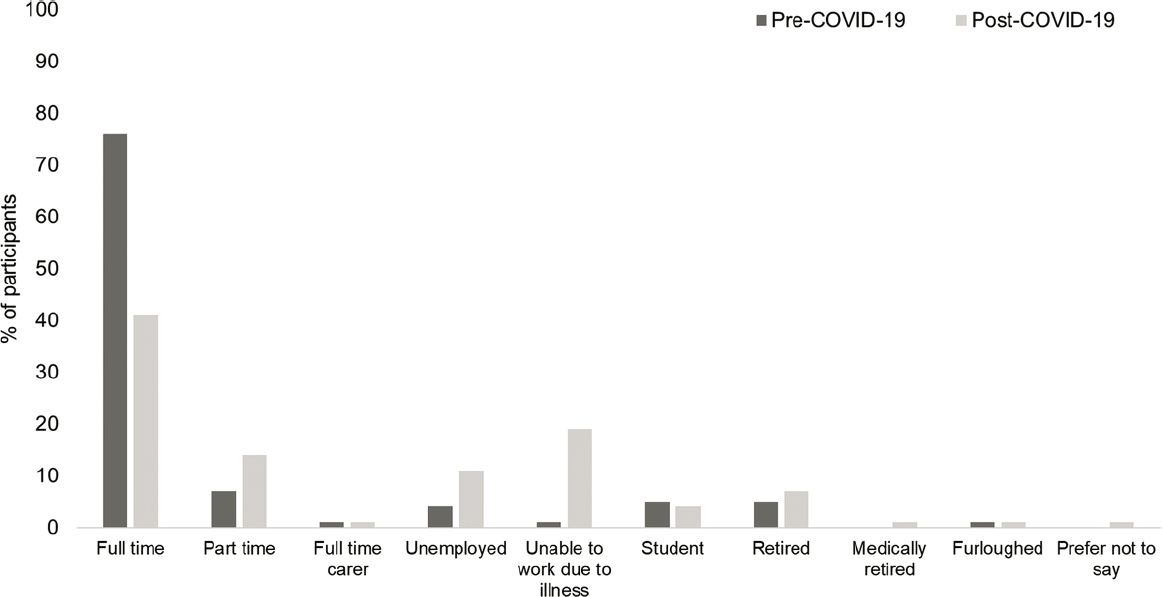
SOURCE: Tabacof et al., 2022, p. 52, in Laura Tabacof presentation, March 22, 2022.
this decrease may be caused by the economic effects of the pandemic, the high percentage of people who reported being unable to work because of illness suggests significant COVID-19-related disability.
In addition to the survey of 156 individuals, Tabacof also presented unpublished data from a survey she and her colleagues conducted with a larger sample of 533 patients with postacute COVID-19; the majority were female, aged 46 on average, and 90 percent had never been hospitalized for acute COVID-19. Respondents answered the same questions used in the smaller sample, addressing fatigue, cognitive impairment, and disability. Using the Fatigue Severity Scale (FSS), 81 percent had scores indicating severe fatigue, with a mean score of 5.4 out of 7. Placed in context with other conditions, said Tabacof, this level of fatigue is comparable to other postviral syndromes, and more severe than levels of fatigue in other chronic neurological conditions (e.g., multiple sclerosis) or in the general population.
On the Neuro QOL Cognitive Function scale, 70 percent of respondents indicated some level of dysfunction, with 51 percent reporting moderate to severe dysfunction (Figure 5-2). In contrast, about 20 percent of the general population is estimated to have moderate to severe cognitive dysfunction (HealthMeasures, n.d.; Iverson et al., 2021), she said. Tabacof emphasized that the postacute COVID-19 cohort was generally younger than the general population, so the difference in cognitive dysfunction may be even greater.
The EuroQol-5D-5L is a self-reported instrument that measures health-related quality of life on a five-component scale: mobility, usual activities, depression/anxiety, self-care, and pain/discomfort. Using this instrument, Tabacof and her colleagues found that over half of the post-acute COVID-19 cohort had moderate, severe, or extreme problems in the areas of usual activities, and just under 50 percent had moderate, severe, or extreme pain/discomfort (Figure 5-3). Anxiety and depression were also measured using the GAD-7 and PHQ-2. Tabacof observed that the exact effect of COVID-19 on mental health is complex to estimate, but these data suggest the levels of anxiety and depression in patients with Long COVID are not that different from normative or baseline values. This, she added, is in contrast to the data on fatigue and cognitive dysfunction, which were notably different from the norm.
Respondents were asked questions about the effect of COVID-19 on their employment status. One-third indicated they were unable to work the same number of hours because of their health, while a quarter were unable to work at all because of their health (Figure 5-4). Of the 217 people who answered a question about disability insurance, 17 had applied, and 7 were approved. Scores on the WHODAS instrument to assess disability demonstrated that more than half of respondents reported some level of disability and about a quarter reported severe or extreme disability, said Tabacof.
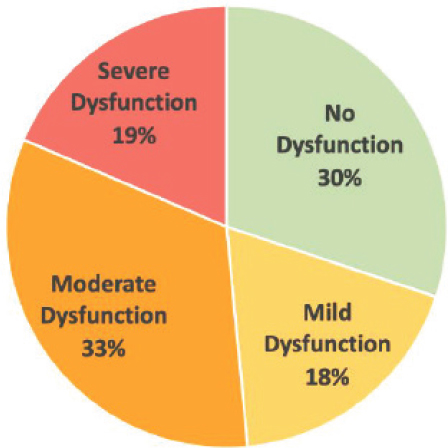
SOURCE: Laura Tabacof presentation, March 22, 2022; unpublished data from the speaker.
In concluding, Tabacof identified five main points from this research:
- Long COVID can reduce function and participation for longer than 12 months, regardless of the severity of acute illness.
- Impairments are comparable or more severe than what is seen in other work-debilitating conditions.
- With no universal biomarker for Long COVID or related disability, diagnosis should be based on patient-reported symptoms or outcomes and clinical evaluation.
- Clinicians should be trained to diagnose Long COVID so prevalence can be determined and proper care can be delivered.
- Investment in local support systems of Long COVID is crucial: rehabilitation, care delivery workforce, and infrastructure.
LIMITATIONS AND IMPAIRMENTS AFTER A STAY IN THE INTENSIVE CARE UNIT
Postintensive care syndrome (PICS) is a well-established condition that affects survivors and families after a stay in the intensive care unit (ICU), said Alba Azola, rehabilitation physician and codirector of the Post-Acute COVID--
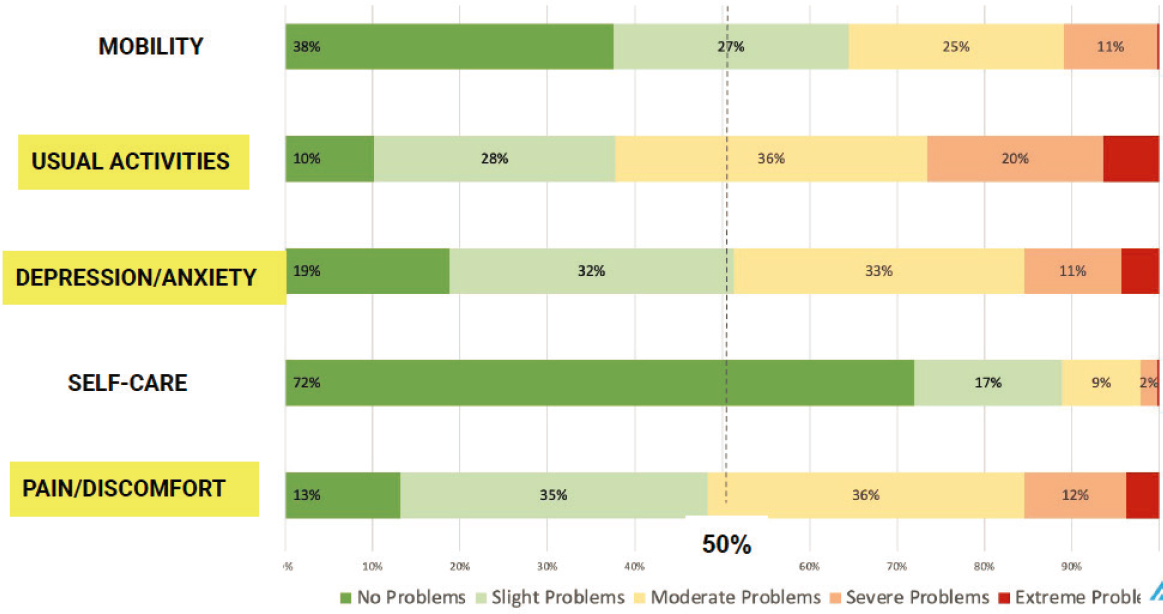
SOURCE: Laura Tabacof presentation, March 22, 2022; unpublished data from the speaker.
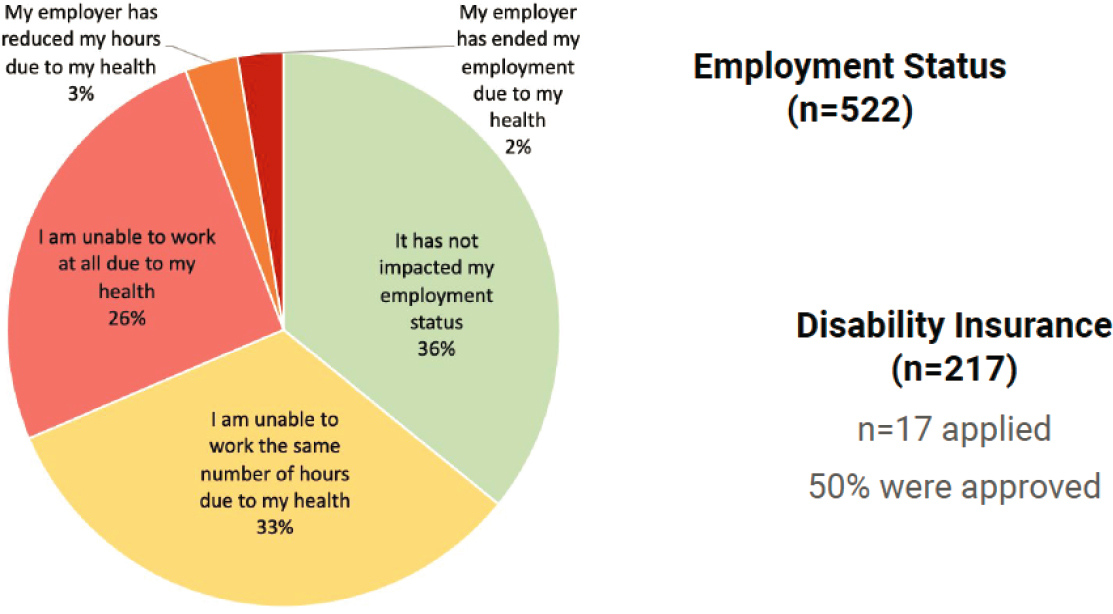
SOURCE: Laura Tabacof presentation, March 22, 2022; unpublished data from the speaker.
19 Team at Johns Hopkins Hospital. The knowledge about this condition can be used to inform the expected outcomes for patients who were in the ICU with acute, severe COVID-19, she said. PICS affects patients in three main areas: mental health, including anxiety, PTSD, and depression; cognitive impairments, including executive function, memory, attention, visuospatial ability, and mental processing speed; and physical impairments, including pulmonary, neuromuscular, and physical function. The family of the survivor may deal with issues of anxiety, PTSD, depression, and complicated grief.
A 2003 study (Herridge et al., 2003) looked at outcomes over time for ICU patients with acute respiratory distress syndrome (ARDS), said Azola. The study found that patients lost about 20 percent of body weight by the time they were discharged, and although they regained most of the weight, the lean muscle tissue that was lost was replaced with fat. Using the 6-minute walk test to measure mobility, patients improved over time but were still below baseline by 12 months. Only half had returned to work at 12 months, and of these, a quarter could not return to their original job or required modifications. Physical impairments included muscle wasting and weakness, foot drop, and joint immobility.
Patients admitted to the ICU during the COVID-19 pandemic experienced a number of environmental and management differences that may worsen their outcomes, said Alba in discussing an analysis of studies (Parker et al., 2021) (Figure 5-5). These patients spent a longer time on mechanical ventilation and experienced frequent position changes; these experiences can worsen myopathy and put patients at risk for peripheral nerve injuries and brachial plexopathies. Mental health and cognition could be worsened by prolonged ICU stays with visitor restrictions, media coverage of the pandemic, and anxiety and grief about the pandemic. Further, patients may have had reduced access to rehabilitation services and may have dealt with fear of infection, lifestyle changes, and social isolation.
Evidence about the outcomes for COVID-19 ICU survivors is beginning to emerge, said Azola. Observed physical impairments include shoulder subluxation, brachial plexus injuries, peripheral nerve injuries, and joint contractures. One study (Wiertz et al., 2021) found that upon admission to acute in-patient rehabilitation, nearly 73 percent of patients had muscle weakness, 13 percent had foot drop, and about 22 percent demonstrated limited range of motion in joints. There was a high risk of dysphagia, with 40 percent of patients admitted to the rehabilitation center still requiring feeding tubes or adapted consistency for meals. Nearly 75 percent of patients still required supplemental oxygen. In terms of cognitive impairment, said Azola, COVID-19 patients who were in the ICU have significantly more impairment than COVID-19 patients who were either not hospitalized or hospitalized but not in the ICU. Mental health was also impaired, with significant propor-
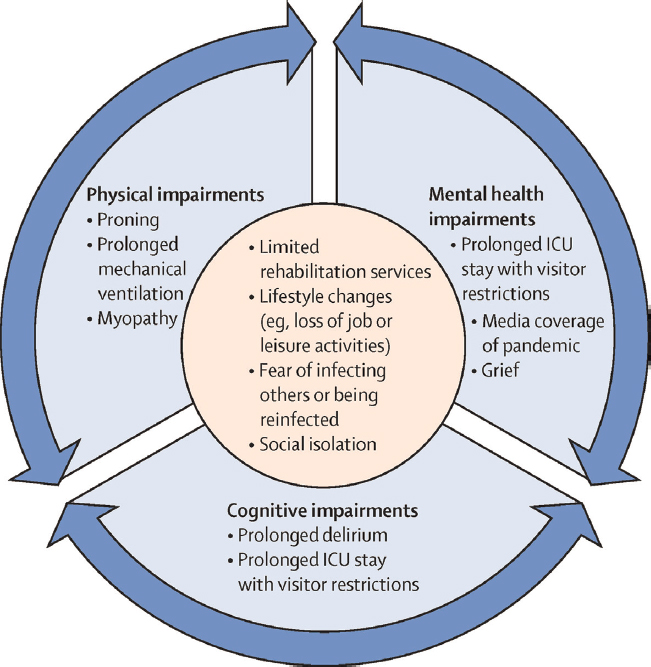
SOURCE: Reprinted from Lancet Respiratory Medicine 9(11), Parker et al., 2021, p. 1331, with permission from Elsevier, in Alba Azola presentation, March 22, 2022.
tions of patients reporting psychiatric distress, functional decline, anxiety, and depression.
Azola summarized her main points:
- A hospital stay in the intensive care unit is associated with physical, cognitive, and mental health impairments that may lead to long-term disability. In one study, more than half the patients were unable to return to work at 12-months.
- Pandemic-related factors can place COVID-19 patients who were in the ICU at greater risk for physical, cognitive, or mental health impairments; limitations on activity; or restrictions on social participation, and thus be at higher risk of long-term disability.
MENTAL HEALTH EFFECTS
As other speakers have discussed, Long COVID patients may have an increased risk of poor mental health outcomes, said Monica Kurylo, professor and director of the Division of Psychology at the University of Kansas Medical Center. These outcomes include diagnoses such as anxiety, depression, PTSD, obsessive-compulsive disorder (OCD), and panic attacks, as well as such symptoms as sleep problems, substance abuse, distress, and low quality of life. The time course of mental health issues in COVID-19 patients is unclear, said Kurylo, and more research is needed in this area. Most studies of mental health have measured outcomes about 4 or 6 months after a COVID-19 diagnosis, while fewer studies measure outcomes at 12 months after acute COVID-19 illness. It is also unclear at this point whether and to what extent mental health symptoms are related to the severity and duration of the acute COVID-19 illness.
As others have mentioned, said Kurylo, it is challenging to untangle the mental health effects of COVID-19 illness from the effects of the pandemic in general. COVID-19 can exacerbate preexisting mental health conditions and can also contribute to new diagnoses and symptoms. For example, sleep problems and substance abuse may exacerbate each other as well as affect other mental and physical symptoms. Other COVID-19-related factors may also affect and be affected by mental health, including grief, loss of family members, financial concerns, racial and ethnic disparities, and community stressors.
Screening for and evaluation of mental health symptoms can be conducted using a variety of tools, said Kurylo, including the Patient Health Questionnaire (PHQ-2) (Kroenke et al., 2003), the Geriatric Depression Scale (Sheikh and Yesavage, 1986), the Beck Depression Inventory (Beck et al., 1988), and the Epworth Sleepiness Scale (Johns, 1991). Treatments depend on the needs and interests of the patients, noted Kurylo, and can include individual therapy, cognitive behavioral therapy, mindfulness training, group therapy, Long COVID support groups, peer support, phone and computer apps, and alternative approaches such as biofeedback and meditation.
CHILD AND ADOLESCENT FUNCTIONING
Children and adolescents have experienced COVID-19 differently than adults in a number of ways, said Alicia Johnston, instructor at Harvard Medical School and codirector of the Multidisciplinary Post-COVID-19 Program at Boston Children’s Hospital. Children are far less likely to have severe disease and to be hospitalized than adults. Most children who develop Long COVID, she said, had mild or even asymptomatic infections. Children generally have fewer comorbidities and are usually previously healthy; because of this, the
symptoms of Long COVID can be a significant departure from baseline for children and families. Young children or those with developmental delays may not be able to articulate their symptoms or concerns, which makes diagnosis of Long COVID more challenging; pediatricians have to rely on histories from people such as parents and teachers to guide treatment and management.
The prevalence of Long COVID in children is unknown, said Johnston, with estimates ranging widely. Earlier in the pandemic, studies suggested that somewhere between 8 and 52 percent of children with confirmed SARS-CoV-2 infections would develop Long COVID (Borch et al., 2022; Buonsenso et al., 2021; Ludvigsson et al., 2021; Say et al., 2021; Zimmermann et al., 2021).
Later studies that included healthy control groups had lower estimates of between 0.8 and 2 percent (Borch et al., 2022; Molteni et al., 2021; Radtke et al., 2021). Children under 5 seem to be less frequently affected and have fewer symptoms than older children and adolescents (Borch et al., 2022; Molteni et al., 2021; Say et al., 2021), although Johnston noted that these children may be less able to communicate their symptoms well. Like in adults, a variety of symptoms have been reported in children that have been attributed to Long COVID, including fatigue, postexertional fatigue, exercise intolerance, dyspnea, cough, dizziness, brain fog, insomnia, muscle weakness, pain, nausea, and anosmia. It is important to note, however, that many of these symptoms are nonspecific and highly prevalent in the general population. In fact, said Johnston, studies that included healthy controls found many children in the control group complaining of ongoing symptoms similar to those reported in the Long COVID group. This begs the question of which symptoms are actually caused by SARS-CoV-2 infection and which might be caused by other factors such as the stress and social isolation of the pandemic.
Johnston gave an overview of the studies on Long COVID that have been conducted in the pediatric population. Far less data are available on children, she said, in part because early in the pandemic there was a focus on higher-risk populations. A 2021 review article (Zimmermann et al., 2021) examined 14 studies of Long COVID in children, and found major limitations in nearly all the studies, including lack of clear case definitions, absence of control groups, low follow-up rates, small sample sizes, reliance on symptom reports without clinical assessment, and multiple types of selection and information biases. Our understanding of Long COVID in children “really lags behind our adult counterparts and underscores the need for well-designed studies with appropriate controls,” she said.
There are many varied potential effects and long-term challenges for children with Long COVID, said Johnston. These include effects on mental health, school absenteeism and performance, social activities, and parental stress and employment, all of which could have long-term consequences. For
example, school nonattendance has been associated with adverse health and social outcomes in both the short and long term, said Johnston. The effects of Long COVID may be particularly acute for children from socioeconomically disadvantaged backgrounds and ethnic minority groups, further exacerbating existing disparities.
The lack of data and the fact that the pandemic began relatively recently makes it difficult to predict the likely outcomes for children with symptoms of Long COVID. While most studies do not have a long follow-up period, they generally show a decrease in the number of symptomatic patients and the burden of the disease over time. Our understanding of other conditions may also be useful in understanding the trajectory of Long COVID, said Johnston. For example, a study on ME/CFS in adolescents found that half reported severe fatigue and physical impairment at 2 years postdiagnosis, and that school and work attendance in the population was low (van Geelan et al., 2010). An older study of 35 adolescents found that 20 percent had ongoing significant symptoms and activity limitation at 13 years after the onset of symptoms (Bell, 2001).
As of March 2022, almost 12.8 million children in the United States have tested positive for COVID-19 (American Academy of Pediatrics, 2022), said Johnston. Using the lower prevalence estimates of 0.8 percent to 2 percent of children developing Long COVID, somewhere between 100,000 and 250,000 children will be affected, she said. If the persistence of Long COVID is similar to ME/CFS, between 20,000 and 50,000 children will enter adulthood with ongoing health needs. However, she said that these numbers are likely an underestimation of the burden of disease. The CDC has reported that around 75 percent of children in the United States have likely been infected with SARS-CoV-2 (Clarke et al., 2022),1 and these numbers continue to grow.
Johnston shared final thoughts:
- Children may experience significant long-term physical, cognitive, social, and emotional limitations because of Long COVID.
- Early recognition and treatment of symptoms and support of return to school and other activities with appropriate accommodations is essential to the overall recovery of children.
- Identification of family stressors (e.g., financial, housing, employment, safety, social isolation) and availability of support systems may provide emotional and logistical support and guide medical therapies.
- Areas of further research include understanding the long-term effect of Long COVID on children as they transition into adulthood is needed.
___________________
1 The speaker updated this information after the workshop.
CLINFIT COVID-19: A NOVEL TOOL TO ASSESS FUNCTIONING
Gerold Stucki, professor and chair of the Department of Health Sciences and Medicine at the University of Lucerne, introduced workshop participants to ClinFIT COVID-19. ClinFIT (Clinical Functioning Information Tool) is a clinical measure that can be tailored to specific population needs and is based on the WHO’s International Classification of Functioning, Disability, and Health (ICF), said Stucki. ClinFIT COVID-19 is being developed in collaboration with the International Society of Physical and Rehabilitation Medicine (Frontera et al., 2019). The ICF is a framework that captures a wide range of a health condition’s implications, including body functions and structures, limitations on activities, environmental factors, and personal factors (Figure 5-6). Using this framework, ClinFIT COVID-19 is being developed as a way to assess people’s lived experience in the clinical context, he said.
There are a number of advantages of using an ICF-based approach, said Stucki. It is an established and internationally recognized reference system for clinical measurement and the standardized reporting of functioning information. The list of functioning domains is mutually exclusive and cumulatively exhaustive. Clinical measures can be tailored in rapid response to public health emergencies, such as COVID-19. Functioning information can be reported independent of the data collection tool or the data source, and data can be easily compared.
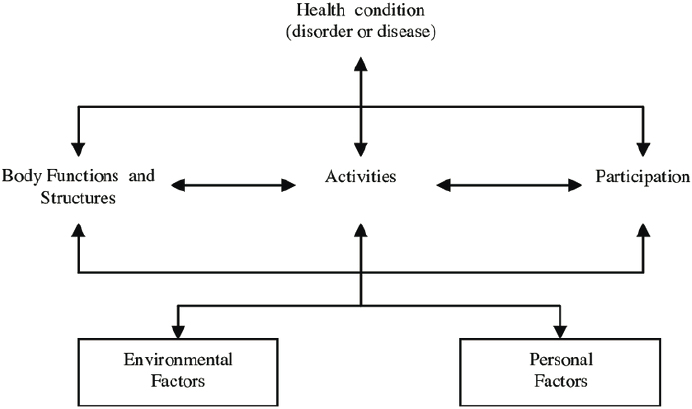
SOURCE: Reproduced from International Classification of Functioning, Disability and Health, WHO, 2001, p. 18, in Gerold Stucki presentation, March 22, 2022.
The first step in the development of this tool, said Stucki, was to identify the functioning domains that matter to people living with Long COVID; this was done through a network of international collaboration. The next step, which is ongoing, is to validate the set of domains in a broader population. Stucki presented the domains that have been identified (Table 5-1). The domains include things that matter to patients, such as pain, emotion, energy, and sleep. Other functional measures include carrying out daily routines, walking, and employment. Stucki said these are universally agreed on measures that can be referred to by anyone in the world.
The next step, he said, is a system for using the tool in clinical practice and collecting the data. The functioning domains are simple descriptions of ICF categories, and experts rate functioning limitations based on all available information (e.g., patient history, patient-reported outcomes, and clinical examinations). Raters can use a 1–10 numeric scale, a 0–4 numeric scale, or a 0–4 scale with specifications. These different scales can then be transferred to a 0–100 scale for statistical purposes. The confidence intervals for each domain depend on the area being measured.
In closing, Stucki reiterated three main points:
- An ICF-based approach can support clinical measurement and standardized reporting of functioning information.
- COVID-19 affects a broad spectrum of functioning domains ranging from body functions to activities and participation.
- ClinFIT COVID-19 is a customizable and easy-to-use clinical measure that captures what matters to people with COVID-19.
DISCUSSION
Malone moderated a question-and-answer session with panelists and workshop participants.
Is there a set of tests or outcome measures that would be useful to SSA in making disability determinations for patients with Long COVID? Is it possible or necessary to look for a biomarker or other definitive signal of Long COVID?
The first step in measuring the effect of Long COVID, said Stucki, is to carefully define what needs to be measured; that is, identify the important domains, including body function and activity limitations. Depending on the domain, different types of tools can be used for measurement, including patient-reported outcome measures, clinical tests, or rating systems. Kurylo added that it is important to use consistent measures to evaluate effect; she noted that measures that are publicly available online can be useful for patients to monitor themselves. There is a complexity to the presentation of Long
TABLE 5-1 ClinFIT COVID-19 Categories
| ICF category (code and title) and corresponding simple description | Acute (n=13) |
Postacute (n=15) |
Longterm (n=16) |
|---|---|---|---|
| b130 Energy and drive functions (G): Psychological energy and motivational drive to move towards goals, satisfy needs and control impulses | ✓ | ✓ | ✓ |
| b134 Sleep functions: Cycle, quality, and amount of sleep | ✓ | ✓ | ✓ |
| b140 Attention functions: ICF book: Specific mental functions focusing on external stimulus or internal experience for the required period of time | ✓ | ✓ | |
| b152 Emotional functions (G): Mental functions for the modulation of the expression of feelings and emotions | ✓ | ✓ | ✓ |
| b280 Sensation of pain (G): Unpleasant sensation indicating potential or actual damage of some body structure | ✓ | ✓ | ✓ |
| b440 Respiratory functions: ICF book: Functions of inhaling air into the lungs, the exchange of gases between air and blood, and exhaling | ✓ | ✓ | ✓ |
| b445 Respiratory muscle functions: ICF book: Functions of the muscles involved in breathing air | ✓ | ✓ | ✓ |
| b455 Exercise tolerance functions: Capacity of enduring physical exertion related to respiratory and cardiovascular functions | ✓ | ✓ | ✓ |
| b710 Mobility of joint functions: Range and ease of movement of a joint | ✓ | ✓ | ✓ |
| b730 Muscle power functions: Capacity to generate force through the contraction of a muscle or muscle groups | ✓ | ✓ | ✓ |
| ICF category (code and title) and corresponding simple description | Acute (n=13) |
Postacute (n=15) |
Longterm (n=16) |
|---|---|---|---|
| d230 Carrying out daily routine (G): Plan, manage and complete routine daily life activities | ✓ | ✓ | ✓ |
| d240 Handling stress and other psychological demands: Manage and control the psychological demands to carry out tasks demanding responsibilities involving stress and/or distractions and/or critical issues | ✓ | ✓ | ✓ |
| d450 Walking (G): Moving in an upright position, step by step, always maintaining a support on the ground | ✓ | ✓ | ✓ |
| d455 Moving around (G): Moving around differently from walking (for example running, going up and down the stairs, jumping, climbing, swimming, etc.) | ✓ | ✓ | |
| d850 Remunerative employment (G): Properly performing remunerative employment (full or part time or self-employed) in all its aspects | ✓ | ||
| d920 Recreation and leisure: Engaging in recreational or leisure activity (play, cultural and sports activities etc., during spare time) | ✓ | ||
| s430 Structure of the respiratory system: ICF book: Trachea, lungs, thoracic cage, muscles of respiration | ✓ | ✓ |
NOTE: Large check symbol = initially proposed categories; Small check symbol = additional categories selected using a multistep process; G = Generic-7 category; ICF = International Classification of Functioning, Disability, and Health.
SOURCE: Selb et al., 2021, p. 182, in Gerold Stucki presentation, March 22, 2022.
COVID, said Azola, and it would be difficult to find one “magic” test. It is a complex syndrome that has multiple facets and affects individuals in different ways; for this reason, it is more useful to look at integrated functional domains to view the patient within the context of their individual impairments and environment. Johnston added that different biomarkers for Long COVID, such as microbiome status, cytokine levels, immunoglobulin levels, are the subject of current research. But, regardless of whether a biomarker exists, she said that what is important from a clinical standpoint is comprehensively evaluating a patient’s dysfunction and determining how to support them.
SSA has a responsibility to accurately and efficiently evaluate claimants while being good stewards of public funds. Is there research to support the validity of patient-reported measures as compared to clinical measures? What are the limitations of patient-reported measures, and are there ways to overcome them?
“It is always going to be a challenge to know for sure the extent to which any given person is giving an accurate assessment of their symptoms,” said Kurylo. We have to place our trust in the patient, and can also rely on the input of loved ones who are observing the patient and seeing how a condition is affecting him or her. Azola shared a perspective from her clinic, saying that they perform objective tests of cognitive dysfunction, and also conduct subjective testing to measure the patient’s perceived level of dysfunction. She said depressed patients tend to perceive more impairment in cognition than the objective test reveals, but that there is “definitely a component of cognitive dysfunction that is separate from their depression and anxiety and posttraumatic stress.”
Tabacof noted that while there are limitations of patient-reported outcomes, including subjectivity and risk of recall bias, there are also limitations of biomarker or clinical testing. There is no universal test or set of tests to diagnose or quantify the effect of Long COVID, and it is unknown if existing tests correlate objectively with levels of impairment. Further, if clinical testing is required for diagnosis of Long COVID, there is a potential to exacerbate health care disparities because of lack of access to testing. Johnston added that certain objective tests—such as neuropsychiatric testing—can be difficult to get conducted in a timely manner, particularly during the pandemic. The current best practice, said Tabacof, is to rely on informed clinical evaluation to identify a cluster of symptoms that is compatible with a diagnosis of Long COVID, and to not use objective laboratory or imaging findings as the only measure of a patient’s well-being.
Is there any way to predict what percentage of people, or which specific individuals, might be unable to work 12 months after an acute COVID-19 infection?
Tabacof replied that this is an important area but not one that she has objective data on at this point. She and her colleagues are analyzing their data about employment to examine whether employment outcomes correlate with other functional assessments and disability level. Kurylo added that while this question is challenging to answer right now, she hopes that this workshop will spur additional research in this area.
What has been learned about the relationship between neurological issues and mental health in Long COVID?
It can be difficult to separate neurological and psychiatric conditions because neurological issues can produce psychiatric symptoms, said Kurylo. While it is important to recognize that there can be a relationship between the two, the critical thing is to address the symptoms in a well-rounded and effective way. Pre-COVID-19 research indicates that the best and longest-lasting mental health treatments are typically a combination of psychotherapy and medication, said Kurylo, and there is reason to hope that this would be the same for Long COVID patients who are experiencing mental health symptoms.
One of the essential requirements of work is the ability to follow instructions with reasonable consistency; is there evidence that Long COVID particularly compromises this ability?
Tabacof said that she and her colleagues are currently conducting data analyses to determine how functional outcomes such as cognitive function, anxiety, and depression affect employment. Azola added that her research has found that some Long COVID patients may have difficulty acquiring new skills or new information. In addition, recall and verbal fluency may be affected, as well as spatial reasoning. For example, some patients have difficulty navigating computer systems that they were familiar with and worked with for several years prior to contracting COVID-19.
SSA typically uses psychological testing (e.g. Wechsler memory scales) to determine the severity or degree of limitations brought on by a mental health impairment. Will these tools continue to remain valid and effective in assessing impairments related to Long COVID?
Kurylo responded that these types of tests are likely to remain useful in assessing Long COVID patients. In her experience, she said, these tests can be helpful for determine the strengths of Long COVID patients, as well as
the challenges. Even with the tests, however, assessment still requires gathering information about changes over time and a degree of speculation about which symptoms are related to Long COVID. Azola said that some of the tests for cognitive performance can be very lengthy, some taking 2 or 3 hours. She has noticed that the length of the test can affect some patients’ performances. Tabacof agreed, and added that some patients are unable to complete a lengthy test, and that doing so can exacerbate their symptoms. Further, said Azola, test performance can fluctuate from day to day, depending on the patient’s symptoms and how well they are being managed. Azola noted that this fluctuation can occur with both psychological and cognitive testing, as well as physical tests such as those for orthostatic intolerance.
This page intentionally left blank.




















